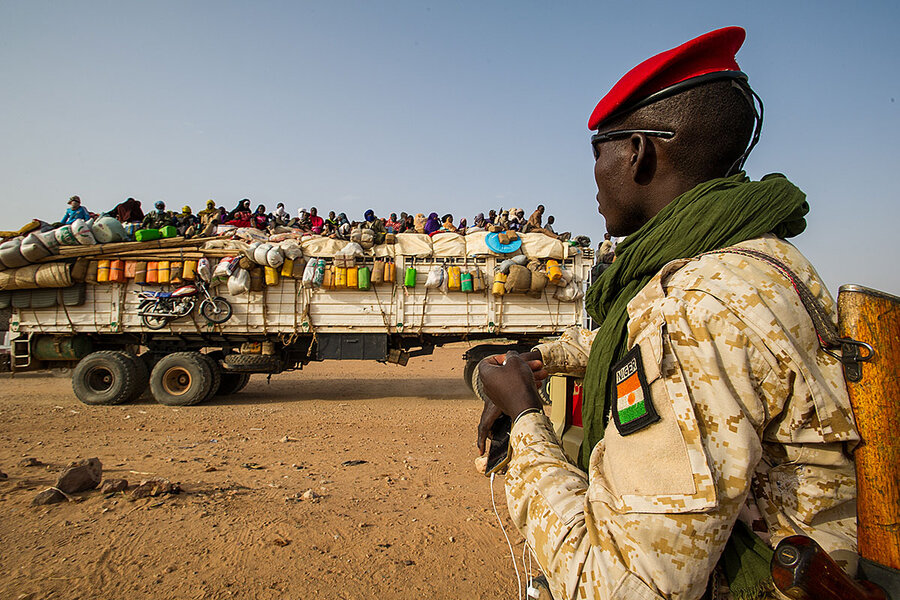In high stakes experiment, EU migration policy moves front lines to Niger
| Agadez, Niger
Mahmane Elhadji, his arms dusted with flour to the elbow, does not look like an advertisement for the European Union. But as he supervises a team kneading dough and cutting it into rolls in his cramped backstreet bakery, Mr. Elhadji finds himself a flag carrier on the front line of Europe’s drive to stifle illegal migration from Africa.
Mr. Elhadji was once a “coaxer.” When disoriented migrants arrived at the bus station here in Agadez, a sweltering adobe-walled town in the southern reaches of the Sahara, his job was to steer them to the people-smuggler for whom he worked. Today, with help from a small EU grant, he runs “Eat Today, Eat Tomorrow,” the name he has chosen for his new business.
“It wasn’t much money and it took a long time to come,” Elhadji says. “But without it I would have gone back to coaxing.”
As divisive political tensions around migrants rise in Europe, governments there are making their broadest-ever bid to choke off the flow close to its source. Elhadji’s story, and those of his neighbors who have gone back to smuggling, illustrate the progress and the pitfalls of the EU’s effort to tempt local people away from the migrant trade.
Elhadji’s cash came from a $270 million “Emergency Trust Fund” that the EU is spending on migration-related projects in Niger, including everything from migrant counseling to job training. The country has become “a centerpiece of EU policy” in northwest Africa, says the European ambassador to Niger, Denisa-Elena Ionete.
“Africa is 14 kilometers from our coast,” she points out. “Africa’s security and development is our security and development. Migration is a part of that.”
Thinning traffic
Which shines the spotlight on Agadez, a historic crossroads town that is today a sprawling sun-baked outpost of scruffy shops, adobe compounds, and sand streets, the last stop before the vast emptiness of the Sahara desert.
Agadez’s prosperity has long been built on the passage of merchandise and people on the move. Once, the migrants were heading to oil-and-job-rich Algeria and Libya; hundreds of thousands of people passed through Agadez quite legally, lining the pockets of the town’s travel agents, drivers, and lodging-house owners.
After Libyan leader Muammar Qaddafi’s overthrow by Western-backed forces in 2011, most travelers set their sights farther north. And at the height of Europe’s migrant crisis in 2015, as more than a million people a year flooded into the continent, the EU turned to Niger for help.
In early 2016 the government suddenly implemented Law 36, which effectively criminalized the transport of foreigners north of Agadez. Overnight the police seized the white Toyota pickups that the migrants had traveled in (102 of them can be seen today, baking in the sun, behind the regional military headquarters), arrested scores of men involved in the migration business, and sentenced 90 of them to jail time, according to the local prosecutor.
“Europe has long been an important partner of ours,” explains Nigerien Interior Minister Mohamed Bazoum in an interview. “Being helpful to the EU is somehow giving them something back” in return for their longstanding aid.
There is little doubt that the new policy has helped cut the number of illegal migrants heading north very substantially. The International Organization for Migration counted 334,000 of them passing through Niger in 2016 and fewer than 50,000 so far this year. A foreign aid worker estimates that there are likely no more than 300 migrants at any one time hiding in houses in Agadez now, compared to at least 2,000 before the law came into effect.
“The law has had an impact,” says Harouna Aggalher, a field officer in Agadez for the International Rescue Committee, a New York based non-profit. “Smugglers are more afraid of getting caught.”
'The desert is vast'
That doesn’t mean that they have all got out of the business. Smugglers are taking new and rarely used routes, or simply trusting their GPS and satellite phones and heading into uncharted desert.
“They’ve changed their strategies and systems,” says Bashir Amma, a former smuggler. He now uses the sandy compound where he once housed migrants as the office of an association seeking more economic assistance for men, like him, who have abandoned the migration business.
Col. Abdoulaye Garba Ango, spick-and-span at military headquarters in his newly pressed camouflage uniform, sends out regular long-range desert patrols to search for vehicles carrying migrants, as well as armed Islamists. But with just a handful of EU-funded Land Cruisers and some new communications gear, he finds it hard to keep an eye on a military region half the size of Texas.
“The desert is vast,” he sighs. “It’s natural that the smugglers should avoid us. We come across some, but others get past.”
How many, nobody knows. But pickups that abandon the established routes, marked by occasional concrete posts, are putting their migrant passengers in great danger, veterans of the migration business warn.
“They are taking a huge risk now,” says a smuggler calling himself Ibidangaz (not his real name), his face half hidden behind the Tuareg turban wrapped around his head.
Ibidangaz himself has stopped driving. But sitting outside his family compound on the very edge of town, where the desert sand drifts against the walls, he says he still “plays hide-and-seek” with the police to connect migrants with drivers. “Until you get that call from Libya saying they’ve arrived, there’s no guarantee at all that they are alive,” he says.
“People die by the hundreds in the desert,” says Ahmadou Bossi, commander of the Agadez National Guard contingent, whose patrols have come across three abandoned truckloads of migrants by chance this year.
That makes Johannes Claes, the local representative of Doctors of the World, a Belgian NGO that helps migrants, wonder about European policy. “If you see the problem as just one of stopping migrant flows, it is a success,” he says. “But if you are causing human suffering and migrants to die, you should consider whether your policy is working.”
Cautionary tales
The drop in migrant numbers is partly due to Law 36, but only partly, says Mr. Bazoum, the Interior Minister. He attributes the fall also to Europe’s increasingly cold shoulder and to “the centers of suffering” in Libya, the militia-run prisons where many migrants end up as slaves or hostages. Even those who make it across the Sahara face brutal treatment in Libya, and that news seems to be deterring other would-be migrants.
Ikena, an athletic-looking 25-year-old from Nigeria who had dreams of playing soccer in Europe, knows all about that.
Today he is back in Agadez: dodging the police, broke, unsure what to do next, and “just praying for help.” But he is better off than he was two months ago: detained by gunmen as soon as he had been dropped off by his smuggler in southern Libya, he was stripped of his belongings and put in a prison, he says.
“Then they kicked me and beat me and flogged me and made a video of it, and sent it to my mother to make her pay,” he recalls. “She sold her land to send them the money so they let me go.”
Back in Agadez he met Moses, a Liberian who had been planning to travel through Libya to Italy. But now he has decided to turn around. “Ikena told me that Libya is no good and that I shouldn’t take the risk,” Moses says. “I’ve definitely changed my mind.”
Problems in the pipeline
Meanwhile, Law 36 “has caused this region a lot of damage,” says Mohamed Anako, president of the Agadez regional council, because it has collapsed the two pillars of the local economy – tourism and transport.
The EU is trying to offset this damage with a $9 million Rapid Economic Impact Action Plan for Agadez and tens of millions of dollars’ worth of other projects, such as a solar-powered electricity generating plant.
But they are mostly still in the pipeline. So far, says city mayor Rhissa Feltou, all the town has to show for the ambitious plans is a project employing 1,000 men and women to sweep the trash-filled sandy streets, a small road-building scheme, and a workshop training masons to repair the adobe buildings in Agadez, a UNESCO heritage site whose 16th century minaret is the tallest mudbrick building in the world.
“There’s a lot of talk about European funds, and I’ve had the whole of Europe come to visit me – ministers, members of parliament, auditors, you name it,” laughs Mr. Feltou, tipping his chair back against the wall of his compound. “All we’ve got to show for it is photographs. The EU is a long way from making up the losses we’ve suffered because of the law.”
Even the project aimed at “actors in the migration field,” as the EU puts it, the one that helped Elhadji set up as a baker, is surrounded by question marks.
Of 2,345 requests for a grant under the program, only 294 were approved before the EU money ran out. The grants were rarely enough by themselves to set up a business, and Elhadji, for example, had to wait a full year after he filed his request before he got his money.
Nor is it clear that the EU money really all went to former smugglers. It was local mayors who were asked to identify eligible candidates; many of them simply listed their friends and relatives, say people familiar with the program.
“We hear dissatisfaction,” acknowledges EU Ambassador Ionete, “but we stand by the project.”
Meanwhile, some disappointed former smugglers are going back to their old trade (and some never left it). “I stopped everything and stayed home for a year, looking after my camels and my livestock, but I got nothing” by way of compensation, says Ibidangaz. “I’ve got seven children; we have to eat. ...I make just enough for the cooking pot these days.”
High stakes
Ninety local men involved in the transport of migrants were jailed under Law 36, which sets penalties ranging from 5 to 10 years, the prosecutor says. None are in Agadez prison anymore, though, according to prison governor Capt. Yacouba Seyni.
All appear to have been given light sentences and then paroled early, in a gesture that local residents say may have something to do with the region’s predilection for rebellion: twice in the past 30 years the Tuaregs of northern Niger have risen up against the central government.
“Migration is a political issue,” points out Souleymane Mohamed, a lawyer working with the International Rescue Committee in Agadez. “When the law shut it down, there was an uproar that led the politicians to go easy.”
Mr. Anako, who was a leader of the 1990 rebellion, says he is worried that if the outside world does not create jobs for young men, increasing numbers will resort to the risky but lucrative smuggling trade.
They may not find many migrants to transport anymore, but they would be well placed to carry other cargo.
“If they lose hope they will go into trafficking, and not just of people but of guns,” Anako warns, echoing a fear Bazoum voices too. With armed Islamist groups fighting the governments of neighboring Mali to the west and Nigeria to the south, and Islamic State and al Qaeda fighters roaming Niger’s northern border with Libya, “an economic crisis here could feed a security crisis,” Anako predicts.
The EU ambassador to Niger, Ms. Ionete, says that the European authorities’ “purpose is to go to the core of the nexus between security and development and migration.” She appears to have her hands full.






